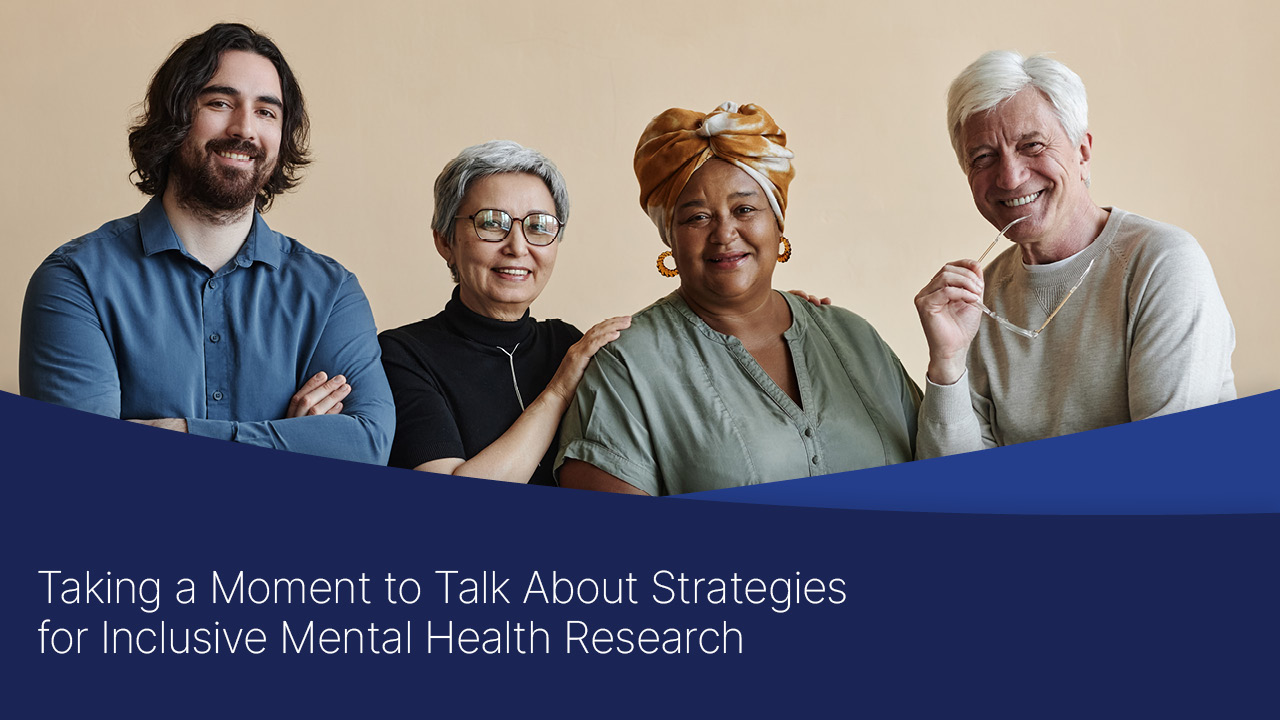As we discussed in our previous blog post, mental health disorders remain largely underdiagnosed and undertreated. In addition to the reasons we discussed in that post, such as a lack of access to mental health services and persistent stigma associated with mental health, a lack of representativeness in clinical research is also an important factor. It could explain why we still don’t completely understand the multifactorial causes of mental health disorders, we lack efficacious treatments for everyone who experiences poor mental health, and we’re unable to identify why some people seek treatment while others don’t.
In this post, we delve a bit deeper into the importance of equity and inclusion and outline strategies to improve the recruitment and enrollment of representative populations in mental health research — to help improve mental health outcomes for all.
Social determinants of health (SDOH) and mental health are closely linked.
The high level of interdependence between SDOH and mental health disorders cannot be overlooked when aiming to include a representative sample for research. Poverty (both individual and neighborhood-level), food insecurity, transportation insecurity, lack of social support, poor employment opportunities, and experiences with racism and discrimination increase the risk of mental health disorders and affect an individual’s ability to seek care when needed.
Early life experiences and cultural differences play an important role in mental health.
When trauma and adversity in the form of low socioeconomic status, household dysfunction, poor nutrition, limited education, and racism (both direct and structural) occur in childhood, there are even greater risks of mental health disorders not only in childhood but also in later life. Moreover, mental health disorders in adolescence and young adulthood can be exacerbated by bullying and comparisons with peers (e.g., at school, on social media).
These experiences, as well as cultural expectations and stigma, can impact how mental health and illness are viewed, an individual’s openness to treatment, and the nature of the therapeutic relationship. Therefore, they are important considerations when planning mental health research with people of all ages.
It’s also important to understand the “culture” of the disorder.
Education about cultural awareness often needs to include education about the “culture” of the mental health disorder. Socioeconomic decline and social isolation are common in patients with schizophrenia, dementia, depression, and addiction. Staff need to understand how mental illness affects the thought patterns, decision-making processes, and behaviors of participants. Increased awareness helps staff adapt and use more flexibility in their interactions with patients, which leads to improved retention during studies.
Dr. Eric Chavez, Principal Investigator and Associate Medical Director at Artemis Institute for Clinical Research, a Headlands Research site, says:
“At Artemis, we used community outreach and educational events such as ‘lunch-and-learns’ in underserved and marginalized neighborhoods (e.g, Hispanic/Latino and LGBTQ), as well as cultural awareness training on site to improve diversity in participant recruitment and retention.”
Non-White racial/ethnic groups are often under-represented in research, under-diagnosed, and under-treated.
To date, clinical trials have not enrolled a meaningful number of racial and ethnic minorities, which could contribute to the lower rates of mental health care received by these population groups. Addressing this disparity in research participation is important owing to the greater prevalence of SDOH-related risk factors in these populations.
Early planning is key to reaching a representative sample.
Participants from a variety of backgrounds should be sought for mental health research to best understand how race/ethnicity, experiences in early life, and SDOH contribute to mental health and healthcare-seeking. Achieving this requires careful consideration of appropriate strategies during study planning, including designing inclusivity into research, improving accessibility to studies, and building trust in the research process.
Design inclusivity into research.
Inclusivity begins with the study design and an intentional approach to reaching and communicating with individuals with poor mental health. Some strategies could include the following:
- Engage with communities to determine barriers to participation and plan to address those when possible.
- Consider cultural competency training for research staff so they can be sensitive to participants’ backgrounds and differences in experience, needs, and expectations.
- Go beyond cultural competency to cultural partnerships that acknowledge the need to re-evaluate the power relationships between researchers and participants in order to provide a more equitable experience.
- Ensure that assessments have been adapted and validated for the population, culturally, linguistically, and for different SES.
- Avoid perpetuating stigma or generalizations about mental health disorders and participant demographic and socioeconomic characteristics through intentional, respectful writing of study materials and final reports.
Improve awareness of research and accessibility to research sites.
Widespread communication of research in general and about specific studies, their objectives, and the benefits could increase awareness within a greater segment of the population. Complementing that with conveniently located study sites could encourage participation. In this area, consider any or all of the following strategies:
- Educate mental health professionals about research opportunities and the referral pathway for their patients.
- Partner with organizations offering mental health services in diverse areas and with diverse staff members.
- Locate sites in places that are easy to access and that respect participants’ potential desire for privacy.
- Disseminate findings of research programs to participants and the larger community at local events.
- Report demographic characteristics in press releases and publications so the public has insight into research that represents them.
Build trust in the research process and reduce the stigma associated with mental health disorders.
Research often suffers from a lack of trust, especially in vulnerable populations. Try to create a welcoming and inclusive research environment that takes the participants’ points of view into account:
- Employ research staff who are representative of the community.
- Describe the study requirements and expectations, especially about how participants’ data will be used, in a way that can be easily understood and trusted by all participants.
- Include dedicated community health workers/liaisons who participants might trust to receive information about the study and its benefits and risks.
- Explore alternative ways to spread the word through trusted organizations and community members, such as via barber shops in Black communities.
- Consider offering the flexibility of completing some assessments or sessions online, which could be considered less stressful, more anonymous, and lower risk than in-person visits.
High-quality mental health care for all is achievable through research.
The study and treatment of mental health disorders benefit from qualified researchers who have experience recruiting, enrolling, and retaining a broad range of individuals. Designing research programs that acknowledge the diverse backgrounds underlying mental health, the sensitivity of the topic, and differences in readiness to participate can help ensure inclusiveness in mental health research. At Headlands Research, our sites have specialists in psychiatry/psychology and dedicated psychometricians to lead and execute clinical trials for mental health disorders. With investigators and clinical research staff who are representative of their communities; strong ties with community health organizations; and targeted, proactive recruitment and retention methods, we are dedicated to improving health disparities through quality research.
Contact us to learn more about our sites’ ability to support your future studies.

